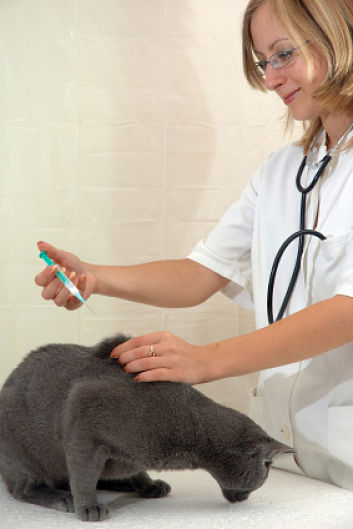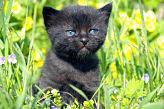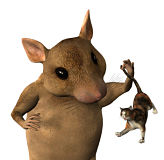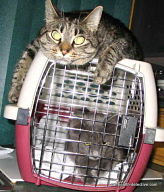Cat Vaccines

Choosing which cat vaccines and knowing how the immune system works is a help. You learn a lot when you take in a few strays like we have over the past few years, you end up taking them to the vet to be checked out. We have them checked for parasites, FIV, FeLV and bring them up to date on their shots.
Since you don't know if the kitten or older cat has had their shots the vet will give them what they should have to bring them up to date depending upon their age. The vaccines activate the immune system and it goes into action.
Cat vaccines are a preparation of a weakened or killed (inactivated) viral pathogen that stimulates the body's immune system to defend itself. Immunization is the process by which the body recognizes a foreign agent and responds by mounting an immune response against the invader. Most result in successful immunization, but, unfortunately, there are no 100% cat vaccines against viral disease.
Even though the immune system is amazing in its complexity, viruses can be sneaky...and avoid detection. Not every animal has the ability to mount a successful immune response. So, take precautions to limit exposure to disease and know that the use of cat vaccines has greatly reduced the prevalence of many infectious disease in cats.
Immune System
The immune system is in a constant state of combat readiness. If a virus invades the body, the body's first response is to sound the alarm. When macrophages...cells that digest foreign particles that enter the body...meet "non-self" organisms during routine cleanup, they summon helper T cells (members of a white blood-cell family called lymphocytes). While macrophages deal with viruses, cells called neutrophils are the first line of defense against bacteria.
Once alerted, helper T cells...whether they've encountered the invader before or not...take charge of the fight. These helper T cells simultaneously multiply and secrete substances that rush the danger message to the spleen and lymph nodes where production of other lymphocytes (T and B cells) immediately shifts into high gear. The immune system is now ready to engage the enemy.
The T and B lymphocytes fight the invader with different strategies. Certain T cells blast holes in infected cells, which destroys the cells that harbor the replicating virus. Virus that spills out of infected cells is then vulnerable to attack. B lymphocytes produce chemical weapons call antibodies. When antibodies locate the invading agent, they either neutralize it or chemically flag it for attack.
Once the invader has been vanquished, two other members of the lymphocyte family play a critical role. Suppressor T cells call off the attack by stopping or slowing down the activities of the combat lymphocytes. Memory cells, long-lived offspring of the B and T cells activated during the attack, continue to patrol the body for years after the attack.
These memory cells retain a memory of the virus and recognize it if it invades again. Therefore, the response to any future attack is much quicker than the first one. The cat body's war against a disease is a race against time. If the immune systems wins the race the cat does not get sick. If the infectious agent wins, the animal gets the disease.
Active and Passive Immunization
Active immunization happens when a cat's immune system recognizes an invader, mobilizes its forces, produces antibodies and memory cells, and defeats the invader. Passive immunization happens when a cat, instead of producing its own antibodies, receives its antibodies from another source. The primary example in nature is the immunization a kitten gets from its mom.
Newborn kittens are born with their immune systems in place but not sufficiently developed to effectively protect them from severe infections. During the brief period following birth, nature helps out by giving them the protection of their mother's antibodies via her antibody-rich first milk (colostrum).
Colostrum
A healthy nursing mother cat produces an ample supply of milk for several weeks after the birth of her kittens but the antibody, rich colostrum is a finite commodity. Each mammary gland contains only so much. Once the kittens empty a mammary gland of its colostrum, the milk they get to ingest is normal nursing milk.
And a kitten's gastrointestinal tract can absorb the antibodies from colostrum only during the first 24 to 48 hours after birth. Most kittens receive adequate colostrum but some do not. A large litter of kittens could drain the glands in a few hours and the slower kittens will arrive too late. So you don't know how well protected a kitten is during its early weeks.
Vaccination Timing
Maternal antibodies block the production of the kitten's own antibodies. So, the maternal antibodies that are so vital for the short-term protection of the kitten actually mitigate against the long-term protection provided by a vaccination. The maternal antibodies wane over the first weeks of a kitten's life.
It is important to begin cat vaccines early enough to protect susceptible kittens. Sometimes somebody will buy an eight-week old kitten or get one from a shelter and be told it has had its shots. But until a kitten is at least four months old, you have to assume it needs an ongoing series of cat vaccines.
A kitten at 6 to 8 weeks of age should receive an FVRCP with additional boosters given every 3 to 4 weeks until 12 weeks old. Kittens who are getting the first of their cat vaccines at an age older than 12 weeks (this includes unvaccinated adult cats) should get an FVRCP and one additional FVRCP booster 3 to 4 weeks later.
All cats should get a rabies shot at 12-16 weeks. A year later the FVRCP and the rabies cat vaccines should be given again. The objective of a cat vaccines program is to protect the cat so it will not get a disease if it comes into contact with an infected animal. So assess the risk...such as has it been in a environment of high exposure...then you may want to begin a cat vaccines program earlier than the generally recommended eight to ten weeks.
Since some cat vaccines such as rabies vaccines can provide immunity for three years, it's not needed to do it more frequently. The FVRCP has had studies done that point out that it also can be given every three years instead of annually.
Optional cat vaccines available are: Chlamydophila felis, a respiratory pathogen that used to be called Chlamydia...the feline leukemia virus (FeLV)...the feline immunodeficiency virus (FIV)...feline infectious peritonitis virus (FIP) ...Bordetella (another respiratory pathogen)...Giardia (an intestinal protozoan)...and cat ringworm (a skin fungus). Some of these shots are thought to be reasonably effective, while others are considered almost useless.
Types of Cat Vaccines
The American Association of Feline Practitioners (AAFP) and the Academy of Feline Medicine publish a set of feline vaccination guidelines for veterinarians to follow. Their guidelines point out the most recent studies on vaccine effectiveness, safety, and duration of immunity.
Currently (2010), they recommend the following: Panleukopenia (cat distemper), herpes-virus (cat flu), calicivirus (upper respiratory) FVRCP, and rabies. The FVRCP vaccine is a multivalent shot that contains viral antigens for several diseases while the rabies shot is a monovalent shot that contains viral antigens for only the rabies virus.
There are several types of shots available. The two most commonly used in feline medicine are killed (inactivated) and modified live-virus (MLV) vaccines. Killed vaccines have been treated so they can't replicate within the vaccinated animal. The advantages of the killed version are that they can't induce disease and they are more stable than other vaccines, meaning they retain their potency.
Disadvantages of the killed version are that more than one dose is usually needed to provide enough protection, plus the protection is not as long lasting as that of the MLV's. However, there are certain killed vaccines such as rabies vaccines that are highly effective.
MLV's contain an altered form of a virus that can't induce clinical disease. The virus can still replicate with the animal and it is this replication that stimulates the cat's immune system. A major advantage of MLV's is that a single dose provides long-lasting protection. The disadvantage of MLV's is that, in rare circumstances, the vaccine can cause full-blown disease in cats with weakened immune systems.
If your
cat has a weakened immune system discuss the benefits and risks of the
vaccine with your veterinarian. Also you shouldn't ever have a pregnant
cat vaccinated. If you have a sick cat, delay vaccinating until they
are well. Elderly cats should receive regular boosters since their
immune systems aren't as competent as they once were.
Recombinant technology is another alternative that has been developed. Scientists isolate and splice one or more fragments of gene-containing DNA from one organism and transfer the fragments to another organism. Scientists started developing recombinant vaccines after they discovered that, in many cases, only one or two fragments of a germ were needed to stimulate an immune response.
Minimizing the amount of foreign material in the vaccine lowers the risk of post-vaccination side effects. The first of these to become available was the rabies vaccine about 10 years ago. Because of coding and the proteins involved in developing these recombinant vaccines, a lot of research is being done to discover the DNA secrets of more infectious organisms which will spur the development of more of these stripped down vaccines.
Most vaccines are injected under the skin..subcutaneously (SQ). Some are also administered intramuscularly (IM), intranasally (IN), or orally. IN-MVL shots provide additional localized protection along the route where viruses most often enter the body.
After an upper respiratory IN vaccination, a cat may manifest a mild form of the disease. It is important that you have your veterinarian give the shot because the manufacturers directions have to be followed exactly. This affects the amount of protection and how quickly it becomes effective.
Serology
There is increasing concern in the veterinary world regarding the over vaccination of cats with repeat Herpes-virus, Calicivirus and Panleukopaenia Virus to name the main ones. Serology measures the level of antibodies against a particular pathogen for FVRCP vaccines.
Cats with high antibody levels are considered to be protected and have no need for another shot. Vaccination should only be done when the antibody level has dropped below the known protective level.
There are not too many veterinarians that can do this testing on site so it is not used as readily as it should be. The sample is sent out to a laboratory to get evaluated which takes several days. The client has to make a visit for the blood withdrawal and if it proves the protection level is lower than it should be, the client has to return to get the FVRCP vaccination. It's inconvenient in this scenario but positive when the results are good and the shot isn't required.
Some vets may continue to administer the shot every 3 years as suggested by the American Association of Feline Practitioners and the Academy of Feline Medicine. Others may choose to test cats annually and vaccinate only when the test shows the need.
Related Articles......
Return from Cat Vaccines to Cat Health Homepage
Having trouble finding what you need? Cat Health Index & Site Map
OR
Do you have a question to ask?...Questions
OR
Do you have a cat story to share?...Simply click here to go to that page!
Copyright@2010-2020 All rights reserved.Cat-health-detective.com
This website is information only. Consult a veterinarian for medical assistance

"Like Us" on Facebook
or...
"Like Us" here




















